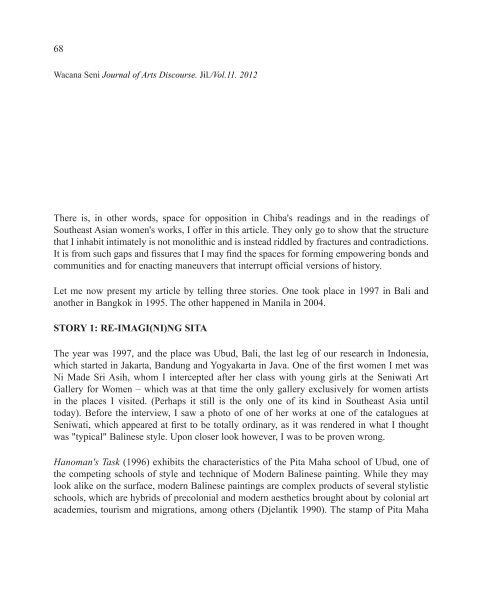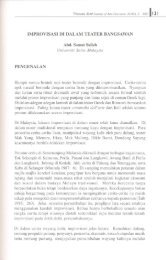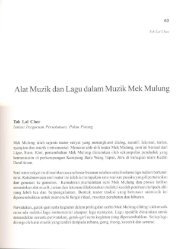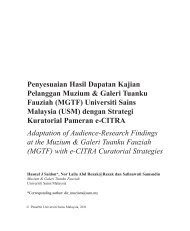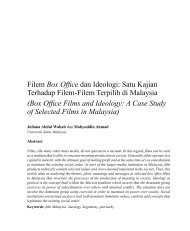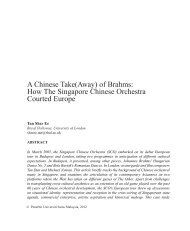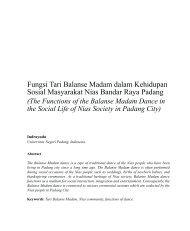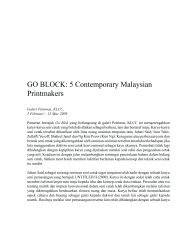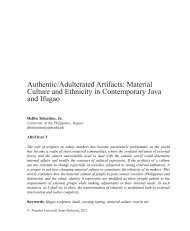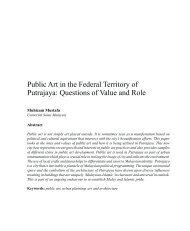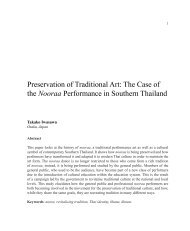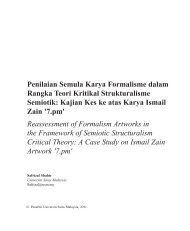Reclaiming The Healing Arts of The Ancient ... - Wacana Seni
Reclaiming The Healing Arts of The Ancient ... - Wacana Seni
Reclaiming The Healing Arts of The Ancient ... - Wacana Seni
Create successful ePaper yourself
Turn your PDF publications into a flip-book with our unique Google optimized e-Paper software.
68<strong>Wacana</strong> <strong>Seni</strong> Journal <strong>of</strong> <strong>Arts</strong> Discourse. Jil./Vol.11. 2012<strong>The</strong>re is, in other words, space for opposition in Chiba's readings and in the readings <strong>of</strong>Southeast Asian women's works, I <strong>of</strong>fer in this article. <strong>The</strong>y only go to show that the structurethat I inhabit intimately is not monolithic and is instead riddled by fractures and contradictions.It is from such gaps and fissures that I may find the spaces for forming empowering bonds andcommunities and for enacting maneuvers that interrupt <strong>of</strong>ficial versions <strong>of</strong> history.Let me now present my article by telling three stories. One took place in 1997 in Bali andanother in Bangkok in 1995. <strong>The</strong> other happened in Manila in 2004.STORY 1: RE-IMAGI(NI)NG SITA<strong>The</strong> year was 1997, and the place was Ubud, Bali, the last leg <strong>of</strong> our research in Indonesia,which started in Jakarta, Bandung and Yogyakarta in Java. One <strong>of</strong> the first women I met wasNi Made Sri Asih, whom I intercepted after her class with young girls at the <strong>Seni</strong>wati ArtGallery for Women – which was at that time the only gallery exclusively for women artistsin the places I visited. (Perhaps it still is the only one <strong>of</strong> its kind in Southeast Asia untiltoday). Before the interview, I saw a photo <strong>of</strong> one <strong>of</strong> her works at one <strong>of</strong> the catalogues at<strong>Seni</strong>wati, which appeared at first to be totally ordinary, as it was rendered in what I thoughtwas "typical" Balinese style. Upon closer look however, I was to be proven wrong.Hanoman's Task (1996) exhibits the characteristics <strong>of</strong> the Pita Maha school <strong>of</strong> Ubud, one <strong>of</strong>the competing schools <strong>of</strong> style and technique <strong>of</strong> Modern Balinese painting. While they maylook alike on the surface, modern Balinese paintings are complex products <strong>of</strong> several stylisticschools, which are hybrids <strong>of</strong> precolonial and modern aesthetics brought about by colonial artacademies, tourism and migrations, among others (Djelantik 1990). <strong>The</strong> stamp <strong>of</strong> Pita Maha


